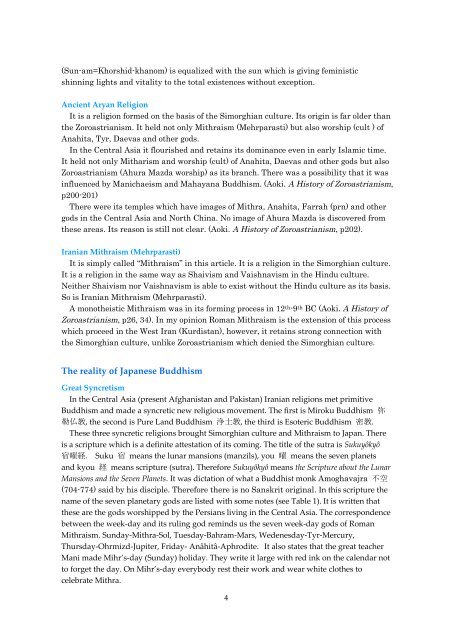An Introduction to the Simorghian Culture and ... - Kaveh Farrokh
An Introduction to the Simorghian Culture and ... - Kaveh Farrokh
An Introduction to the Simorghian Culture and ... - Kaveh Farrokh
You also want an ePaper? Increase the reach of your titles
YUMPU automatically turns print PDFs into web optimized ePapers that Google loves.
(Sun-am=Khorshid-khanom) is equalized with <strong>the</strong> sun which is giving feministic<br />
shinning lights <strong>and</strong> vitality <strong>to</strong> <strong>the</strong> <strong>to</strong>tal existences without exception.<br />
<strong>An</strong>cient Aryan Religion<br />
It is a religion formed on <strong>the</strong> basis of <strong>the</strong> <strong>Simorghian</strong> culture. Its origin is far older than<br />
<strong>the</strong> Zoroastrianism. It held not only Mithraism (Mehrparasti) but also worship (cult ) of<br />
<strong>An</strong>ahita, Tyr, Daevas <strong>and</strong> o<strong>the</strong>r gods.<br />
In <strong>the</strong> Central Asia it flourished <strong>and</strong> retains its dominance even in early Islamic time.<br />
It held not only Mitharism <strong>and</strong> worship (cult) of <strong>An</strong>ahita, Daevas <strong>and</strong> o<strong>the</strong>r gods but also<br />
Zoroastrianism (Ahura Mazda worship) as its branch. There was a possibility that it was<br />
influenced by Manichaeism <strong>and</strong> Mahayana Buddhism. (Aoki. A His<strong>to</strong>ry of Zoroastrianism,<br />
p200-201)<br />
There were its temples which have images of Mithra, <strong>An</strong>ahita, Farrah (prn) <strong>and</strong> o<strong>the</strong>r<br />
gods in <strong>the</strong> Central Asia <strong>and</strong> North China. No image of Ahura Mazda is discovered from<br />
<strong>the</strong>se areas. Its reason is still not clear. (Aoki. A His<strong>to</strong>ry of Zoroastrianism, p202).<br />
Iranian Mithraism (Mehrparasti)<br />
It is simply called “Mithraism” in this article. It is a religion in <strong>the</strong> <strong>Simorghian</strong> culture.<br />
It is a religion in <strong>the</strong> same way as Shaivism <strong>and</strong> Vaishnavism in <strong>the</strong> Hindu culture.<br />
Nei<strong>the</strong>r Shaivism nor Vaishnavism is able <strong>to</strong> exist without <strong>the</strong> Hindu culture as its basis.<br />
So is Iranian Mithraism (Mehrparasti).<br />
A mono<strong>the</strong>istic Mithraism was in its forming process in 12 th-9 th BC (Aoki. A His<strong>to</strong>ry of<br />
Zoroastrianism, p26, 34). In my opinion Roman Mithraism is <strong>the</strong> extension of this process<br />
which proceed in <strong>the</strong> West Iran (Kurdistan), however, it retains strong connection with<br />
<strong>the</strong> <strong>Simorghian</strong> culture, unlike Zoroastrianism which denied <strong>the</strong> <strong>Simorghian</strong> culture.<br />
The reality of Japanese Buddhism<br />
Great Syncretism<br />
In <strong>the</strong> Central Asia (present Afghanistan <strong>and</strong> Pakistan) Iranian religions met primitive<br />
Buddhism <strong>and</strong> made a syncretic new religious movement. The first is Miroku Buddhism 弥<br />
勒仏教, <strong>the</strong> second is Pure L<strong>and</strong> Buddhism 浄土教, <strong>the</strong> third is Esoteric Buddhism 密教.<br />
These three syncretic religions brought <strong>Simorghian</strong> culture <strong>and</strong> Mithraism <strong>to</strong> Japan. There<br />
is a scripture which is a definite attestation of its coming. The title of <strong>the</strong> sutra is Sukuyôkyô<br />
宿曜経. Suku 宿 means <strong>the</strong> lunar mansions (manzils), you 曜 means <strong>the</strong> seven planets<br />
<strong>and</strong> kyou 経 means scripture (sutra). Therefore Sukuyôkyô means <strong>the</strong> Scripture about <strong>the</strong> Lunar<br />
Mansions <strong>and</strong> <strong>the</strong> Seven Planets. It was dictation of what a Buddhist monk Amoghavajra 不空<br />
(704-774) said by his disciple. Therefore <strong>the</strong>re is no Sanskrit original. In this scripture <strong>the</strong><br />
name of <strong>the</strong> seven planetary gods are listed with some notes (see Table 1). It is written that<br />
<strong>the</strong>se are <strong>the</strong> gods worshipped by <strong>the</strong> Persians living in <strong>the</strong> Central Asia. The correspondence<br />
between <strong>the</strong> week-day <strong>and</strong> its ruling god reminds us <strong>the</strong> seven week-day gods of Roman<br />
Mithraism. Sunday-Mithra-Sol, Tuesday-Bahram-Mars, Wedenesday-Tyr-Mercury,<br />
Thursday-Ohrmizd-Jupiter, Friday- <strong>An</strong>âhitâ-Aphrodite. It also states that <strong>the</strong> great teacher<br />
Mani made Mihr’s-day (Sunday) holiday. They write it large with red ink on <strong>the</strong> calendar not<br />
<strong>to</strong> forget <strong>the</strong> day. On Mihr’s-day everybody rest <strong>the</strong>ir work <strong>and</strong> wear white clo<strong>the</strong>s <strong>to</strong><br />
celebrate Mithra.<br />
4
















